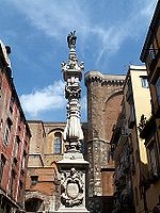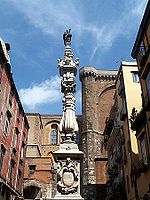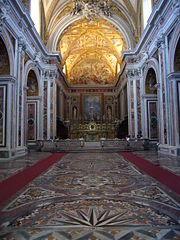
Cosimo Fanzago
Encyclopedia

Baroque
The Baroque is a period and the style that used exaggerated motion and clear, easily interpreted detail to produce drama, tension, exuberance, and grandeur in sculpture, painting, literature, dance, and music...
period in Naples
Naples
Naples is a city in Southern Italy, situated on the country's west coast by the Gulf of Naples. Lying between two notable volcanic regions, Mount Vesuvius and the Phlegraean Fields, it is the capital of the region of Campania and of the province of Naples...
, Italy
Italy
Italy , officially the Italian Republic languages]] under the European Charter for Regional or Minority Languages. In each of these, Italy's official name is as follows:;;;;;;;;), is a unitary parliamentary republic in South-Central Europe. To the north it borders France, Switzerland, Austria and...
.
Biography
Fanzago was born in ClusoneClusone
Clusone is a town and comune in the province of Bergamo, Lombardy, Italy. Located in the Val Seriana, it received the honorary title of city on 15 May 1957 with a presidential decree which ratified a Napoleon's promise of the year 1801....
(current Province of Bergamo
Province of Bergamo
The Province of Bergamo is a province in the Lombardy region of Italy. It has a population of 1,098,740 , an area of 2,722.86 square km, and contains 244 comuni...
) in a family of bronze-casters and architects. In 1608, after a short stay in Chieti
Chieti
Chieti is a city and comune in Central Italy, 200 km northeast of Rome. It is the capital of the Province of Chieti in the Abruzzo region...
, he moved to Naples. Here (according to what he wrote in 1612) he trained as a marble sculptor (maestro di scultura di marmo) and mason under the Tuscan sculptor Angelo Landi. His first important work was the sepulchre of Mario Carafa, a relative of Cardinal Carafa. His architectural debut was the design of San Giuseppe dei Vecchi a S. Potito (completed 1669).
According to an essay about Fanzago's life by count Fogaccia, in Naples he obtained the support of the Benedictines, the Duke of Medina, Prince Caracciolo and the Carthusians, and soon opened a workshop of his own.
Apparently involved in Masaniello
Masaniello
Masaniello was a Neapolitan fisherman, who became leader of the revolt against Spanish Habsburg rule in Naples in 1647.-Name and place of birth:...
's revolt, Fanzago was sentenced to death and had to flee to Rome where he worked for decade. He returned to Naples and designed the church of Santa Maria Egiziaca a Pizzofalcone (1651–1717) and Santa Teresa a Chiaia. His last great church was Santa Maria Maggiore, built between 1653 and 1675. The church of Santa Maria Egiziaca displays a Greek cross plan, and resembles a hybrid of contemporary Baroque masterpieces by Bernini (dome resembles Sant' Andrea al Quirinale) and Borromini (the plan resembles Sant'Agnese).
Fanzago died at an age of 87 years. One of his pupils was Lorenzo Vaccaro
Lorenzo Vaccaro
Lorenzo Vaccaro was an Italian late-Baroque sculptor. He worked in a formalized restrained style.He was born in Naples, the son of a lawyer. He apprenticed with Cosimo Fanzago and Dionisio Lazzari. He was a close friend of Francesco Solimena...
.

Main works in Naples
His works in Naples include:- the Guglia di San GennaroCathedral of NaplesNaples Cathedral is a Roman Catholic cathedral, the main church of Naples, southern Italy, and the seat of the Archbishop of Naples. It is widely known as the Cattedrale di San Gennaro, in honour of Saint Januarius, the city's patron saint, but is actually dedicated to the Assumption of the...
, a votive spire in honor of the patron saint of Naples. It was in imitation of the large portable structures common in religious processions and was the model for two other prominent spiresSpires of NaplesThe Spires of Naples are three monument columns in the historic center of the city of Naples, Italy. The term "plague column" is commonly used in English for such structures since in many places in Europe such columns were built to celebrate the end of — or deliverance from — the plague...
, which he helped plan (at Piazza del Gesù Nuovo and Piazza S. Domenico Maggiore). It was a so-called "plague column"; that is, a spire built in thanks for having been spared from the recent epidemic. - Extensive work on the Certosa di San MartinoCertosa di San MartinoThe Certosa di San Martino is a former monastery complex, now a museum, in Naples, southern Italy. It is the most visible landmark of the city, perched atop the Vomero hill that commands the gulf. A Carthusian monastery, it was finished and inaugurated under the rule of Queen Joan I in 1368. It...
, including the spectacular central courtyard with its large portals and busts of Carthusian saints. - The facades or facade details of numerous churches, chapels, and civic buildings, including Santa Maria degli Angeli (near the Botanical Gardens), anonymous works within the Cathedral of Naples, the Chiesa dell'Ascensione a Chiaia (1622); the facade of Santa Maria della Sapienza (1638–41); the bronze gate of the chapel of the royal treasury; and the original design for church of San Francesco Saverio (now San Ferdinando, across the square from the Royal Palace);
- The Cacace Chapel and Chapel of Saint Anthony in San Lorenzo Maggiore.
- Altars within churches, such as in Santa Maria la NovaSanta Maria La NovaSanta Maria la Nova is a church in Naples, southern Italy. It is located on the site given to the Franciscan order in 1279 when Charles of Anjou decided to build his Castel Nuovo , or Maschio Angioino, on the grounds of the order's original monastery, whence the name Nova .The "new" church was...
, Saints Severino and Sossio, Santa Maria di Costantinopoli, and the church of San Pietro a Maiella (the site of the music conservatory). - Public fountains, including the Gigante near Santa Lucia and the Sebeto fountain at MergellinaMergellina.Mergellina is a section of the city of Naples in the Campania region of Italy. It is at the west end of the seaside road, via Caracciolo, one mile away from the main port of Naples.-Overview:...
. - Villa Donn'AnnaVilla Donn'AnnaVilla Donn'Anna is a historic residence in Naples, Italy. It sits prominently at water's edge at the beginning of the Posillipo coast, just west of the Mergellina boat harbor. The building is on the site of the so-called "Rocks of the Siren" and, indeed, was originally called La Villa Sirena...
at PosillipoPosillipoPosillipo is a residential quarter of Naples, southern Italy, located along the northern coast of the Gulf of Naples; it is called Pusilleco in the Neapolitan language.-Geography:...
. - A number of works outside of Naples, including within the Benedictine Abbey of Montecassino and San Nicola in Venice.

